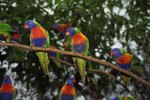Long, curly feathers set the Sebastopol goose apart, making it a decorative and sometimes cuddly goose to have on your homestead. Males and females are autosexing at birth, but if you don't band their legs to keep track of who's who by the time their feathers grow in, it will be virtually impossible to tell them apart by looks alone.
Blonde Boys and Gray Girls
Although most Sebastopols mature as white adults, they hatch with coats of gray and yellow down. Males tend to have yellow down with a gray saddle across their shoulders and back. The girls are covered in gray from head to tail with yellow on the neck, under the wings and on the abdomen.
Boys Will Be Boys
Subtle differences in behavior give clues to your Sebastopol's gender. Males are more protective and usually have their heads up looking around, even at mealtime. They're the first to hiss and stretch out their necks when a threat approaches and they carry their beaks pointed slightly upward. A female Sebastopol carries her beak pointed slightly downward and tends to be less disturbed when visitors approach her pen. Should you see Sebastopols mating, the male will always be on top.
Size Matters
Male Sebastopol geese are heavier than the females, weighing 12 to 14 pounds or more. Females are slightly more petite, weighing in at 10 to 12 pounds. The positive way to tell a male from female Sebastopol is by vent sexing. Females have bigger vent openings than males once they are laying eggs, and a male's corkscrew penis can be seen when carefully probing his vent.
References
Writer Bio
Indulging her passion for vacation vagary through the written word on a full-time basis since 2010, travel funster Jodi Thornton-O'Connell guides readers to the unexpected, quirky, and awe-inspiring.



